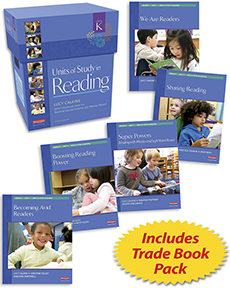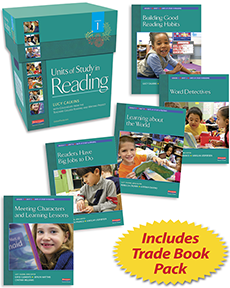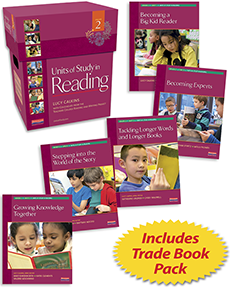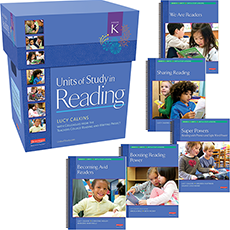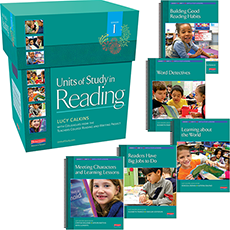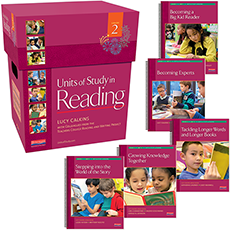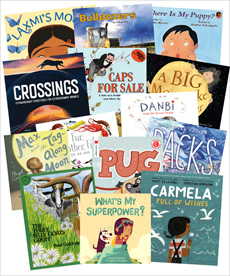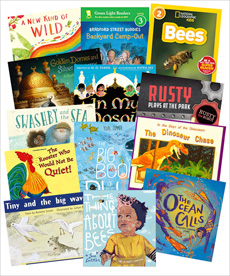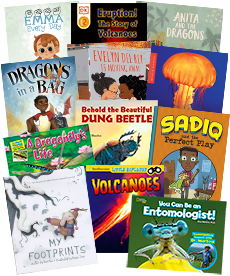Units of Study in Reading, Grades K–2
The new primary edition of Units of Study in Reading is a comprehensive reading curriculum designed in alignment with the latest research about how kids learn to read, bringing science of reading components into every lesson.

The new units focus on structured whole class instruction, including:
- phonological awareness
- explicit phonics lessons
- decoding practice in isolation and in text
- support for fluency and oral language development.
You’ll find rich text sets and engaging storylines. You’ll find five units of knowledge-building curriculum per grade-level. Each unit is built around a sequence of challenging texts at the target Lexile level with vocabulary and comprehension support included. You’ll find embedded professional development for educators, summarizing the research around children’s reading development progression and providing instruction in the best methods to teach essential skills. What you won’t find is instruction anchored in three-cueing or that encourages kids to guess at words in lieu of decoding.
By pairing intense work in classrooms with ongoing deep study of research, Units of Study in Reading, K–2 offers a proven, scientifically based literacy approach that gives ownership to students and fosters powerful communities of learning.
Series Components
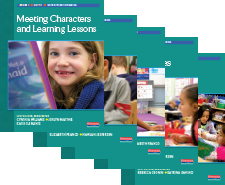
There are five Units of Study in Reading for each grade level, and each unit represents four to six weeks of teaching.
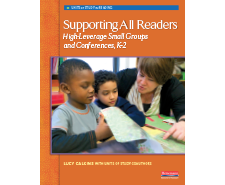
Supporting All Readers is a collection of ready-to-teach conferring supports and small group lessons designed to help teachers meet the needs of the wide range of learners in their classrooms. Also available as a separate purchase.
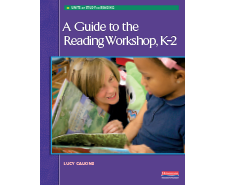
A Guide to the Reading Workshop, K–2 offers a comprehensive introduction to the Units of Study in Reading series.
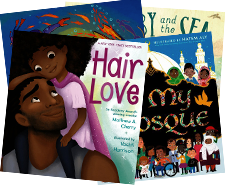
Trade Book Packs include books that teachers use as demonstration texts to model the skills and strategies they want students to try.
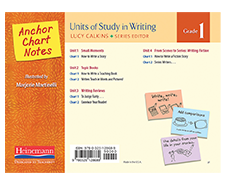
Anchor Chart Sticky Notes featuring each day’s teaching point help teachers create and evolve anchor charts across the units.

You'll find a rich array of digital resources to support each unit of study on Heinemann Flight. See note below about the difference between included Online Resources and the optional Premium Digital Content Subscriptions.
Additional Resources to Support the Units of Study in Reading, K–2

Let's Gather: Reading to and with Your Students provides teachers with complete interactive read-aloud and shared reading plans.

The fiction and nonfiction Jump Rope Readers provide cumulative decoding practice across a gradual phonics progression that supports skill-building.
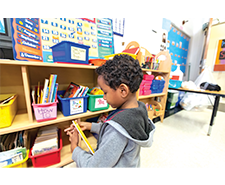
Beginning readers need access to diverse grade-level Classroom Library shelves along with plenty of decodable texts.

New Units of Study Digital Content Overview
Online Resources (included with the core units sets) offer digital access to anchor charts, assessment tools, demonstration texts, small groups and conferring tools, instructional videos, Spanish-language video introductions for every session across all units, and Spanish translations of teaching points, anchor charts, and video introduction scripts.
Both the Online Resources included with every core set of units and the Premium Digital Subscriptions (available by yearly subscription to users of the core units sets) are hosted on Heinemann Flight, a new platform that organizes digital content, book by book and session by session, all in one convenient place and allows administrators to manage teachers' access.
About the Units of Study in Reading, K–2
Units of Study in Reading, Grade K
The Units of Study in Reading for Kindergarten are designed to help you introduce your students not only to the reading workshop but also to school.
In Unit 1, We Are Readers, your task will be to get your kids excited about reading and to help them feel comfortable in the classroom. Students will work to develop essential pre-reading skills, and they’ll practice these skills both on their own and with their peers. In Unit 2, Sharing Reading, you’ll channel your students to pay attention to the words in books. Students will learn to read text from left to right, one word after another, with one-to-one correspondence. They’ll also draw on their growing knowledge of high-frequency words and of the alphabetic code to read familiar patterned books. In Unit 3, Super Powers: Reading with Phonics and Sight Word Power, you’ll rally kids to do the hard work of decoding. They will learn to use new superpowers: “slider power”—the ability to slide through the sounds of words and blend them back together, “think power” to notice and wonder about the content of what they are reading, and “fix-it power,” which helps kids look closely at a challenging word and check to make sure it makes sense. Throughout Unit 4, Boosting Reading Power, students will continue to build on the superpowers they attained in the first three units. You’ll help give these powers a “turbo boost” to help young readers tackle texts with greater complexity. Finally, in Unit 5, Becoming Avid Readers, you’ll build upon and celebrate the journey youngsters have taken since the start of the year.





Units of Study in Reading, Grade 1
The Units of Study in Reading for Grade 1 are designed to help your students continue to build on all of the skills they learned throughout kindergarten, and to help them develop good reading habits they’ll carry with them through the rest of their academic careers and beyond.
In Unit 1, Building Good Reading Habits, it will be your job to get students excited about reading and to model the habits of good readers. Students will continue to develop their decoding skills and will be able to monitor for sense and self-correct with increased accuracy. Unit 2, Word Detectives, begins with the discovery of a top-secret, mysterious envelope from the Super-Secret Detective Agency, inviting your class to take on the role of word detectives. They’ll continue to build vocabulary, building up a bank of snap words, and they’ll practice monitoring for comprehension. Across Unit 3, Learning about the World, you’ll balance your teaching between decoding work and the nonfiction reading skills that will be important in helping children learn from books. Unit 4, Readers Have Big Jobs to Do, marks an important juncture in the reading lives of many of your students as they make the shift from a reading diet of decodable books and carefully selected leveled texts to one of less-controlled trade books. Finally, in Unit 5, Meeting Characters and Learning Lessons, you’ll teach some essential comprehension strategies, lifting the level of readers’ work from earlier units.





Units of Study in Reading, Grade 2
The Units of Study in Reading for Grade 2 are built to remind students of all the incredible skills they learned in first grade and to transition them into the big kid work of being a second grader.
In Unit 1, Becoming a Big Kid Reader, you’ll teach your students how to read with greater fluency and help them develop strategies to become efficient and flexible word solvers as they encounter trickier words. Throughout Unit 2, Becoming Experts, you’ll invite kids into the fascinating world of nonfiction reading, ushering them into the unit by suggesting that good readers of nonfiction are interested in everything. They’ll learn to read closely, with wide-awake attention to detail. At the start of Unit 3, Tackling Longer Words and Longer Books, you’ll ask for your students’ help in refurbishing your classroom library. Throughout this process, students will begin to work through more difficult words and will practice scooping up longer phrases. In Unit 4, Stepping into the World of the Story, you’ll invite students to think about the incredible power that reading has to take us on adventures, on field trips, to faraway places, and to familiar neighborhoods. Finally, in Unit 5, Growing Knowledge Together, you’ll amplify the importance of reading partnerships, helping your students talk and collaborate in new and more rigorous ways. Students will work independently and with reading groups to make sense of more challenging texts.





Additional Resources to Support the Units of Study in Reading, K–2

Supporting All Readers
Responsive Teaching to Support ALL Learners
What if you could more easily support students for small group work in your early primary classroom? Supporting All Readers is a collection of conferring supports and small group lessons designed to help teachers meet the needs of the wide range of learners in their classrooms. It includes ready-to-teach small groups and conferences focused on major reading development goals, and is organized into skill progressions that range from more supportive to more advanced. You can ensure that all readers in your classroom are set up successfully to progress along a trajectory of development.
Supporting All Readers is included with each grade-level bundle. It is also
available as a separate purchase.
Learn more about
Supporting All Readers.

United We Learn
Launch Students into Collaborative Nonfiction Reading
With an emphasis on social justice and culturally responsive teaching, United We Learn launches students into collaborative nonfiction reading.
In this stand-alone unit, the importance of partnerships is amplified, with a focus on helping young learners talk and collaborate in new and more rigorous ways. This spotlight on talk and collaboration is part of a larger focus on classrooms as generous, supportive, culturally responsive learning communities.
United We Learn includes 19 sessions across three bends, one of which is a video session accessible in Heinemann Flight. Each session builds in such a way that the work of one bend provides a foundation for the work of the next. By the end of this unit, children will have learned the power of collaborating in partnerships and clubs to grow knowledge while thinking critically about texts, their identities, their peers, and the world.
This unit has been designed to be used in both second- and third-grade
classrooms, and you’ll find tips throughout the unit on how to differentiate
when needed.
Learn more about
United We Learn.

Let’s Gather
Let’s Gather provides grade-level specific read-aloud and shared
reading plans to use with and alongside the Units of Study in Reading or to
supplement any other resources you use to teach reading. These thoughtfully curated
fiction and nonfiction texts will not only captivate students’ attention, but
also lend themselves to supporting a progression of high-level comprehension skills
across the year. There are plans for first reads and rereads and include regular
opportunities for partner talk and whole-class conversations, helping teachers learn
ways to support students in having collaborative, text-based discussions.
Let’s Gather also includes several templates for
shared-reading sessions that teachers can use and adapt across multiple texts. The
shared-reading lesson plans in Let’s Gather provide opportunities for the
whole class to read a text aloud together and are especially useful for teaching and
reinforcing phonological awareness, concepts about print, word-solving strategies,
and fluency.
Learn more about Let’s Gather.

Jump Rope Readers Decodable Books
The Jump Rope Readers are a series of high-interest fiction and nonfiction decodable books that gradually and systematically introduce beginning readers to new letter-sound correspondences and high-frequency words.
The Jump Rope Readers are arranged into different series, each starring a distinctive main character that students will enjoy getting to know. The fiction series begins very simply, introducing a new phonics concept along with one or two high-frequency words in each book. From there, each book builds on previous books, introducing one or two letter-sound correspondences along with a couple new high-frequency words.
Once students finish a fiction series, they can move to the corresponding nonfiction books. The nonfiction decodables offer a sequence of landings for readers to pause, review, and practice what they have learned up to that point, while learning about new content in a new genre.
Learn more about Jump Rope Readers.
Samples and Overview
To learn more about the Units of Study in Reading, Grades K–2, download the Overview and Sampler.
Ordering Information
To order, Contact your Heinemann sales rep or Customer Service at or 800-225-5800.


